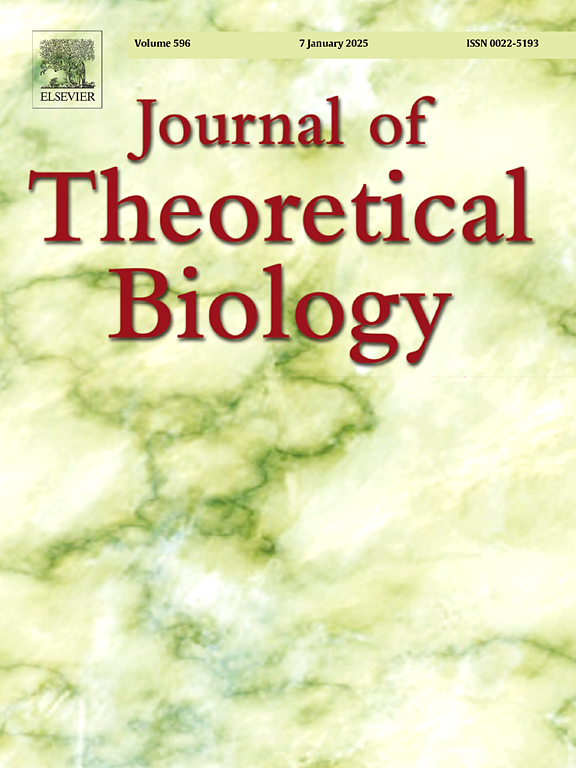Many-strategy games in groups with relatives and the evolution of coordinated cooperation
IF 2
4区 数学
Q2 BIOLOGY
引用次数: 0
Abstract
Humans often cooperate in groups with friends and family members with varying degrees of genetic relatedness. Past kin selection can also be relevant to interactions between strangers, explaining how the cooperation first arose in the ancestral population. However, modelling the effects of relatedness is difficult when the benefits of cooperation scale nonlinearly with the number of cooperators (e.g., economies of scale). Here, we present a direct fitness method for rigorously accounting for kin selection in -player interactions with discrete strategies, where a genetically homophilic group-formation model is used to calculate the necessary higher-order relatedness coefficients. Our approach allows us to properly account for non-additive fitness effects between relatives (synergy). Analytical expressions for dynamics are obtained, and they can be solved numerically for modestly sized groups and numbers of strategies. We illustrate with an example where group members can verbally agree (cheap talk) to contribute to a public good with a sigmoidal benefit function, and we find that such coordinated cooperation is favoured by kin selection. As interactions switched from family to strangers, in order for coordinated cooperation to persist and for the population to resist invasion by liars, either some level of homophily must be maintained or following through on the agreement must be in the self-interests of contributors. Our approach is useful for scenarios where fitness effects are non-additive and the strategies are best modelled in a discrete way, such as behaviours that require a cognitive ‘leap’ of insight into the situation (e.g., shared intentionality, punishment).
亲属群体多策略博弈与协调合作的演化
人类经常与具有不同程度遗传亲缘关系的朋友和家庭成员合作。过去的亲缘选择也可能与陌生人之间的互动有关,这解释了合作最初是如何在祖先群体中出现的。然而,当合作的利益与合作者的数量呈非线性关系时(例如,规模经济),建立关联效应的模型是困难的。在这里,我们提出了一种直接适应度方法,用于严格计算具有m个离散策略的n人相互作用中的亲缘选择,其中使用遗传同族群体形成模型来计算必要的高阶关联系数。我们的方法允许我们适当地考虑亲属之间的非加性适应度效应(协同作用)。得到了动力学的解析表达式,对于中等规模的群体和中等数量的策略,可以进行数值求解。我们用一个例子来说明,小组成员可以口头同意(廉价谈话)为具有s型利益函数的公共产品做出贡献,我们发现这种协调合作受到亲缘选择的青睐。随着互动从家庭转向陌生人,为了保持协调合作,为了让人们抵抗骗子的入侵,要么必须保持某种程度的同质性,要么必须遵守协议,以符合贡献者的自身利益。我们的方法适用于适应度效应是非加性的,并且策略最好以离散方式建模的场景,例如需要对情境进行认知“飞跃”的行为(例如,共享意向性,惩罚)。
本文章由计算机程序翻译,如有差异,请以英文原文为准。
求助全文
约1分钟内获得全文
求助全文
来源期刊
CiteScore
4.20
自引率
5.00%
发文量
218
审稿时长
51 days
期刊介绍:
The Journal of Theoretical Biology is the leading forum for theoretical perspectives that give insight into biological processes. It covers a very wide range of topics and is of interest to biologists in many areas of research, including:
• Brain and Neuroscience
• Cancer Growth and Treatment
• Cell Biology
• Developmental Biology
• Ecology
• Evolution
• Immunology,
• Infectious and non-infectious Diseases,
• Mathematical, Computational, Biophysical and Statistical Modeling
• Microbiology, Molecular Biology, and Biochemistry
• Networks and Complex Systems
• Physiology
• Pharmacodynamics
• Animal Behavior and Game Theory
Acceptable papers are those that bear significant importance on the biology per se being presented, and not on the mathematical analysis. Papers that include some data or experimental material bearing on theory will be considered, including those that contain comparative study, statistical data analysis, mathematical proof, computer simulations, experiments, field observations, or even philosophical arguments, which are all methods to support or reject theoretical ideas. However, there should be a concerted effort to make papers intelligible to biologists in the chosen field.

 求助内容:
求助内容: 应助结果提醒方式:
应助结果提醒方式:


